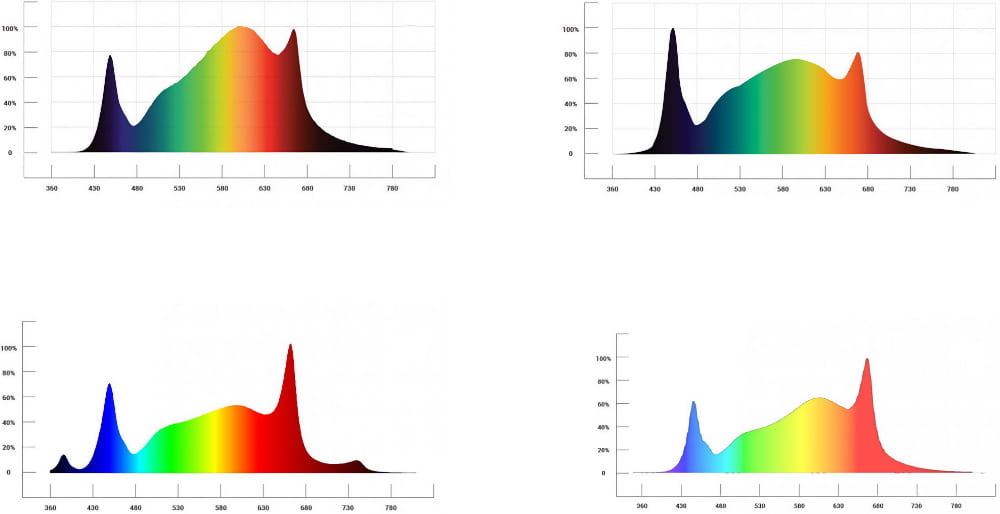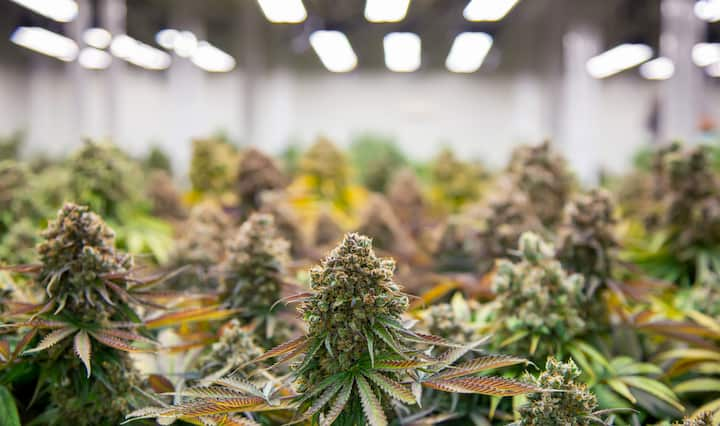
Lighting for indoor cannabis growing has evolved quite a bit in the last few years, with LED grow lights being a top choice for both professional and recreational cultivators.
LED grow lights for cannabis – a quick history
Since discovering electricity, people have been growing all kinds of plants indoors. Unfortunately, they had little luck as, compared to the sun, the indoor light proved minuscule. Fast forward to the 20th century, and indoor cultivation methods improved drastically, along with the introduction of LED grow lights later.
The first LED invention was in 1961 when the idea was patented by Texas Instruments, even though “unofficially”, it was a Russian named Oleg Vladimirovich Losev who invented the first LED light in 1927. However, there was no practical use for it at the time.
The innovations in this industry finally led to the advancement in LED grow lights. They have grown massively in popularity between 2013 and today, with many growers using them to achieve great results, which we’ve mainly witnessed over the last 3-to 4 years.
Full-spectrum LED grow lights for optimal results

If you’re thinking about investing in quality LED grow lights, then you stand to benefit in many ways (we’ll be covering that in this guide too). However, it’s essential to know what full spectrum LED grow lights are before anything else.
Cultivators have been using natural light from the sun for years in greenhouses, although it isn’t always practical. This is where full spectrum LED grow lights come in as they mimic the sun’s natural light as closely as possible.
Where traditional LED grow lights typically use a combination of red and blue LEDs only (pinkish-purplish light is emitted as a result), full-spectrum LED grow lights use the entire spectrum (light from the full ultraviolet to infrared range, just like the sun). This light source appears mostly white, but it doesn’t necessarily make it full-spectrum by default because an LED light is white.
It’s more beneficial to use LED grow lights that emit the full spectrum as it closely mimics actual sun rays, helping you obtain higher yields. For this reason, you’ll find that white LEDs are notably more expensive than those which emit red or blue light only.
Light spectrum impact on cannabis plant
The full spectrum grow lights emit UV, Blue, Green, Red, Far red, and every type has its main impact on the plant.

UV – slows the growth and enhances oil production. UV light does drive photosynthesis and might also trigger cannabinoid synthesis and potentially reduce disease.
Blue – reduces cell expansion, thus plants get shorter and reduce leaf expansion.
Green – penetrates leaves and facilitates human vision. Green wavelengths penetrate deep in the leaf and are absorbed by certain plant pigments which benefit the plant.
Red – chlorophyll strongly absorbs red light, thus it is effective at photosynthesis.
Far red – enhances cell expansion, plants stretch.
How to identify quality LED grow lights: PAR, PPF, and PPFD
As you continue to become an experienced grower and find new ways to improve your yield, it will benefit you to familiarise yourself with some acronyms for indoor plant growing.
What is PAR?
Photosynthetic Active Radiation (PAR) describes the wavelengths of light within the visible range: 400 to 700nm (nm is the unit used to measure wavelength). It’s not a metric like feet or inches, but rather a term that helps cannabis growers determine two things: the type and volume of light required to optimize the plants’ yield and health.
When purchasing LED grow lights, PAR is an important consideration because the more PAR your light can produce, the more PAR available to plants, the better they will grow.
What is PPF?
Photosynthetic Photon Flux (PPF) is the term we use to define the measurement of PAR. Its underlying value determines how much PAR your LED grow lights can produce per second. The PPF measurement helps you understand how much of the light your fixtures are producing, which can be used by your marijuana plants for photosynthesis.
PPF is measured in micromoles per second or “µMol/s”, where one micromole is equal to approximately 602 quadrillion photons. Measuring your PPF properly requires a thorough understanding of the process and a little bit of mathematical subtleness and patience. And while there are PPF measurement tools that can be purchased from the open market, you might work with a trusted partner who can help you choose the perfect LED grow lights that are efficient enough to provide the desired PAR and PPF.
The most popular LED lights on the market currently deliver from 2000 to 2900 µmol/s.
What is PPFD?
Photosynthetic Photon Flux Density (PPFD) is the third and final part of the PAR equation. PPFD measures not just the PPF but also the surface area. The unit for measurement is micromoles per square meter per second or “µMol/m²/s”, which is used to determine how many PAR photons are effectively landing on a given area. So, PPFD has to do with how many of those crucial photosynthetic photons actually positively impact the growing area and how efficiently your LED grow lights are working in terms of output.
As a cannabis grower, you need to bear in mind the distance from the light source. A few measurements can be used as an average (the minimum and maximum ratio) before buying LED grow light. We’d again recommend working with a trusted LED grow light partner who can provide the necessary and reliable metrics.
Beyond what we’ve explained for these three terms, it can all get extremely technical, which may serve more counterintuitive for the average grower than anything else. Your LED grow light partner can help you understand the best lighting system needed according to your specific growing needs.
How much PPFD is needed to grow cannabis?

The average cannabis plant in a regular “home-scale” operation requires a PPFD of 100-300 μmol/m²/s during the seedling phase, 400-600 μmol/m²/s during the vegetative stage, and 800-1,000 μmol/m²/s during the flowering period. These are just baseline values for food photons that are needed to grow a strong and healthy plant.
Each marijuana plant has a genetic saturation point, after which PPFD’s benefits start to taper off. It is wrong for growers to assume that the more PPFD they have at their disposal, the better and generally higher the yields – this simply isn’t true because more PPFD does not always translate to “more plant”. Also, giving your plant too much full-spectrum light at specific growth phases can lead to a higher risk of plant health problems, such as nutrient burn, water deprivation, and light burn.
Distance from the plants
Let’s do a quick recap of what we discussed in the previous section to do more justice to understanding this section correctly!
PAR is the portion of the visible spectrum light that plants can “see” and effectively use for the photosynthesis process, right? This occurs within the 400nm to 700nm range. PPFD measures how much PAR your plant can receive over time (light density that the plant will receive). PPFD can be visualized in a way similar to how the sun “pours” light onto plants – the leaves suck up energy as the sun bathes them with its light.
PPFD is a critical metric to consider when we talk about the distance of plants from different-powered LED lights – it allows you to accurately measure the light intensity of the photosynthesis process at the roof level. So, for example, if you place your LED grow lights too close to the plant’s surface or canopy, you can cause stunted growth, bleaching, and even discoloration.
Now, keeping the above in mind, here are average PPFD/PAR values according to your plant canopy height and the light footprint or coverage they might provide.
| Plant roof/canopy (meters) | Light intensity (lux) | PPFD (µMol/m²/s) | Coverage (m²) |
| 2 | 955 | 670 | 7.6 |
| 1.5 | 1692 | 1170 | 5 |
| 1 | 3663 | 1670 | 3 |
| 0.5 | 12500 | 2170 | 1.5 |
| 0.2 | 50300 | 2670 | 0.5 |
The reference table above uses a 600W LED light for reference, which is performed at different distances from the plant roof/canopy. As you can see, the light intensity and subsequent coverage area change as the distance between the light source and canopy increases/decreases. The coverage can vary according to the grow light you’re using.
Generally speaking, LED grow lights need to be closer to your canopy for the vegetative and flowering stages; therefore, as the light source moves closer to the canopy, the light intensity increases.
For seedlings, we’d recommend that your LED grow lights be no lower than 36-60 inches (0.9m to 1.5m), although these are just baseline values, as the power or wattage of the light source influences the values. Most LED lights have a dimming function, so growers keep it at a minimum and increase it gradually over the following weeks.
If you keep your LED grow lights at the highest range (60 inches), this will keep the light intensity levels from being overbearing and prevent the seedlings from drying out. Once they have taken root and the sprouting begins, you can move the lights closer in the first 2-3 weeks and/or increase power using the dimming function.
Your lights can be anywhere between 0.3m and 0.6m above the plant canopy in the vegetative and flowering stages. At this point, you need more light for photosynthesis to take place, so your LED grow lights will need to be closer to the plants, naturally.
Here’s a quick reference guide on LED grow light distance:
- Seedlings: 0.9-1.5m (36-60in)
- Vegetative stage: 0.4 – 0.6m (15-24in)
- Flowering stage: 0.3 – 0.5m (12-20)
All in all, the peak output (wattage) of your LED grow lights is what determines the optimal distance as you start out with the growing process.
LED grow lights beam angle
Equally important is the beam angle of your LED grow lights. For example, at a 120° angle, your lights will cast a wider net or coverage, which is ideal if you want to fit as many plants as possible within a specific coverage area. With that said, since 120° casts a broader net, it is not as concentrated as, say, a 90° or 60° angle. This means that light will not penetrate the lower levels of your plant very well because the wider your beam is, the lower the intensity will be.
Beam angles are achieved using lenses on LED diodes. Worth mentioning, that these lenses lower the efficacy levels of the LED light fixture.
Why is LED more efficient to use than other grow lights?
Even though they are more expensive, LED lights help save up on electricity costs and are much better for the environment than traditional grow lights. LEDs are also fundamentally different (and better) from conventional grow light sources because they contain no lead, mercury, gas, or filament. They also do not have a fragile glass bulb or any failure-prone parts. They are a very cost-effective and super-green solution that can easily last you 50000 hours and more.
So, no matter how you look at it, LED growing lights are more durable, efficient, versatile, and much longer-lasting than HPS.
How to choose the correct LED grow light?
Without overcomplicating things or getting too technical, here’s a good rule of thumb to go by:
- The larger your area, the more “coverage” you need, which means you’ll be looking at more powerful and bigger LED lights which a higher average PPFD.
- PPFD values are the most accurate way of comparing the performance of various LED grow lights and help determine the ideal light height from the canopy according to your space.
- Many growers make the mistake of picking their LED grow lights on a “watt per sq. ft.” basis, and this is just plain wrong. You should be looking at the PPFD output and how your lights spread out over the desired area – PPFD values from a trusted supplier will always paint the most accurate picture and help you choose the right light system.
What are the advantages and disadvantages of LED lights?
PROS
- Compared to HID lights and other conventional options, LEDs are far more energy-efficient (up to 40% savings in bills), durable, and last longer too.
- LEDs run very cool and produce a lot less heat than other options.
- You can move your plants closer to LED lights as it produces less heat.
- LEDs can be dimmed if you want and work on an instant on/off principle; they do not require any ‘warming up’.
CONS
- LEDs may be more expensive upfront, although they do offer savings in the long run.
- LEDs don’t produce any infrared energy, which means you need to keep your grow rooms warm, starting at ideally 25-27°C.
- LEDs don’t dry up grow rooms like HPS lights. Therefore, growers have to fight increased humidity.
Best-known grow lights brands
Nowadays who can find quite a lot of led grow lights under different brand names. When comes to quality, not all will deliver the same results. We always recommend choosing a known brand that will fulfill every parameter promised. Here is the short list of trusted ones:
- Lumatek
- Nokotech
- Mars hydro
- Spider farmer
- Gavita
- Vivosun
Closing thoughts
We hope you found this engaging and insightful – many factors come into play when it comes to growing your plant with LED lights. Luckily, the key principles have been outlined in this article, leaving you to look after your plant in a responsible manner!
Frequently Asked Questions (FAQs)
Why the humidity is much higher growing with LED lights compared with HPS?
LED lights emit very low heat so they do not dry up the air. HPS light bulbs get super hot so they dry up the surrounding air.
Recommended humidity in the flowering stage is between 45-55%. Many growers choose to mix LED lights with HPS lights in the same grow room to be able to control the humidity levels better and keep the grow rooms warm when it’s cold outside.
How much PPFD do plants need?
The average cannabis plant in a regular “home-scale” operation requires a PPFD of 100-300 μmol/m²/s during the seedling phase, 400-600 μmol/m²/s during the vegetative stage, and 800-1,000 μmol/m²/s during the flowering period. These are just baseline values for food photons that are needed to grow a strong and healthy plant.


